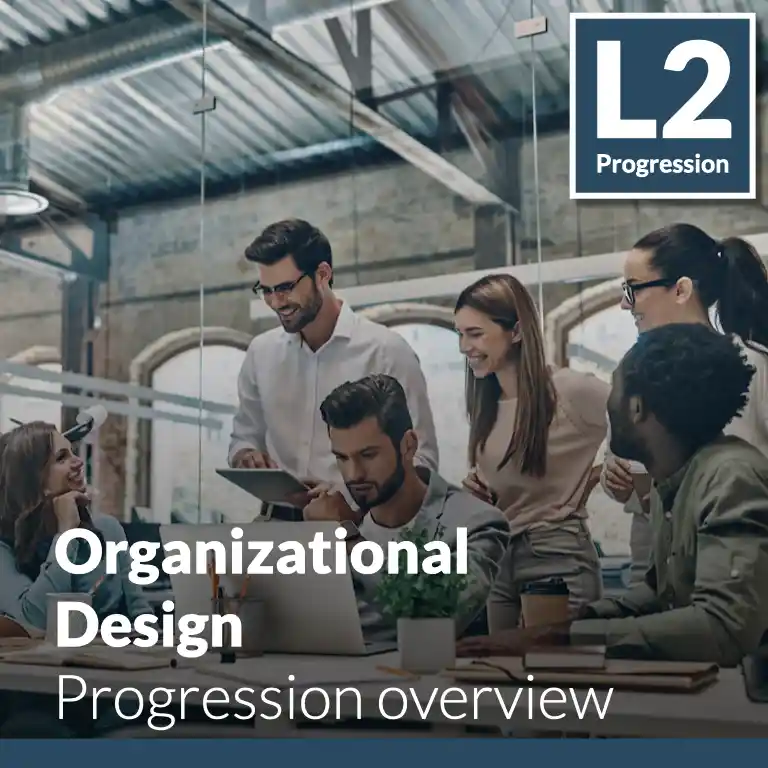Enjoy instant access to a scalable system of proven practices and execution-ready tools. Built to launch strategic HR programs 5X faster!
✓ Enjoy platform access
✓ Create your HR roadmap
✓ View open content in library
✓ Access dozens of practices:
⤷ The HR Strategy program
⤷ Explainers and deep dives
⤷ Supplemental guides
⤷ Insight articles
⤷ Weekly best practices
⤷ And more!
100% Free. No credit card required.
This guide is part of a progression set comprised of Core, Advanced, and Emerging Organizational Design practices.
Effective coordination requires more than just an established organizational structure. It is best facilitated when all aspects of the organization work together to help the organization accomplish its goals. Designing an organization requires formalizing a structure that enables and enhances repeatable execution of core business processes with cross-functional collaboration. This structure drives interconnection and sharing of data, ideas, and insights, which can significantly improve operational efficiencies and effectiveness. This includes establishing an “operating model,” or a representation of how work gets done to achieve the organization’s goals. An operating model clarifies how different parts of the organization coordinate with each other to complete key tasks, how information is shared, and how performance gets measured and rewarded.
Leading practice at this level includes drilling into the critical workflows in a manner that formally documents how each aspect of strategically important work tasks are executed and accomplished step-by-step. These include formal process flowcharts that define each role (individual job or department) involved in completing the tasks and making decisions, as well as the actual actions themselves. At this level, process governance and decision rights are clearly defined, with the various roles contributing to the work throughout the process execution being formally called out and assigned. Performance metrics are determined based on the business priorities and objectives of each participating function/department and built to clarify each member's contributions to success. Given those performance indicators, appropriate incentives are developed to reward and encourage the key elements of those contributions.
Companies need effective coordination to be able to compete in today’s increasingly complex and competitive business environment. The need for coordination is only heightened as organizations grow and mature. Organizations should be designed to facilitate value-creating linkages between individuals and teams enterprise-wide. The ultimate value lies in the formal structuring and reinforcement of the desired contributions – who will make those contributions, how they will do so in relationship with other roles and teams/functions, the standardized manner in which the associated tasks will be accomplished, who will be held accountable for taking action and making decisions, how those will be measured and managed, and how the various roles will receive reinforcement for conducting those activities on a successful and continuing basis. The output of such activities should be well-aligned to lead to successful contributions to larger organizational goals. In the case of a well-functioning operation, the structure provided by these practices helps to heighten the likelihood of successful goal achievement. A combination of formal governance and subsequent measurement of critical performance indicators offer a solid and repeatable method for overseeing the extent to which the design is successfully aiding the organization to improve its outcomes and, if not, to identify design flaws that can be corrected for future success.
When well-designed and executed, these practices create a clearly defined linkage between parts of the organization whose efforts require collaboration and connection. They identify the capabilities (know-how, expertise, processes) the organization will develop and utilize to create stakeholder value and achieve its goals. They categorize all the capabilities regarding their strategic value and criticality to operations to create a vivid picture of what is essential and requires an ongoing focus for sustainable excellence and competitiveness. They develop a view of the enablers needed to manage those capabilities through decision-making, people management, and governance considerations that can be brought to life and integrated into a sound, well-designed organizational structure.
As an organization employs many people, providing them with structured guidance and context for how they conduct business on a daily basis is a necessity that is enabled through formal documentation of work processes and expected information flows. When coupled with clearly outlined maps of task responsibilities, clarity of how responsibilities for each primary task and workflow are shared and decisions made, reliable process execution can be ensured, with the most suitable experts driving work completion. Furthering the benefits of such a structured approach to task assignment, the creation and fielding of associated performance measures and aligned incentives drive the ability to track progress and outcomes and adherence to work and decision-making protocols while providing suitable rewards and recognition for quality work and results.
Designing a model to identify how all aspects of the organization will work to both implement the business strategy and achieve prioritized goals.
Creating and documenting major workflows to clarify tasks that are to be performed in an organization and identify the information that is needed for and generated by each task.
Assigning responsibilities and accountabilities for critical decisions and actions to be taken in each step of key business processes.
Identifying key performance indicators and reporting tools that can be used to monitor processes and measure employee performance in alignment with business objectives.

Enjoy instant access to a scalable system of proven practices and execution-ready tools. Built to launch strategic HR programs 5X faster!